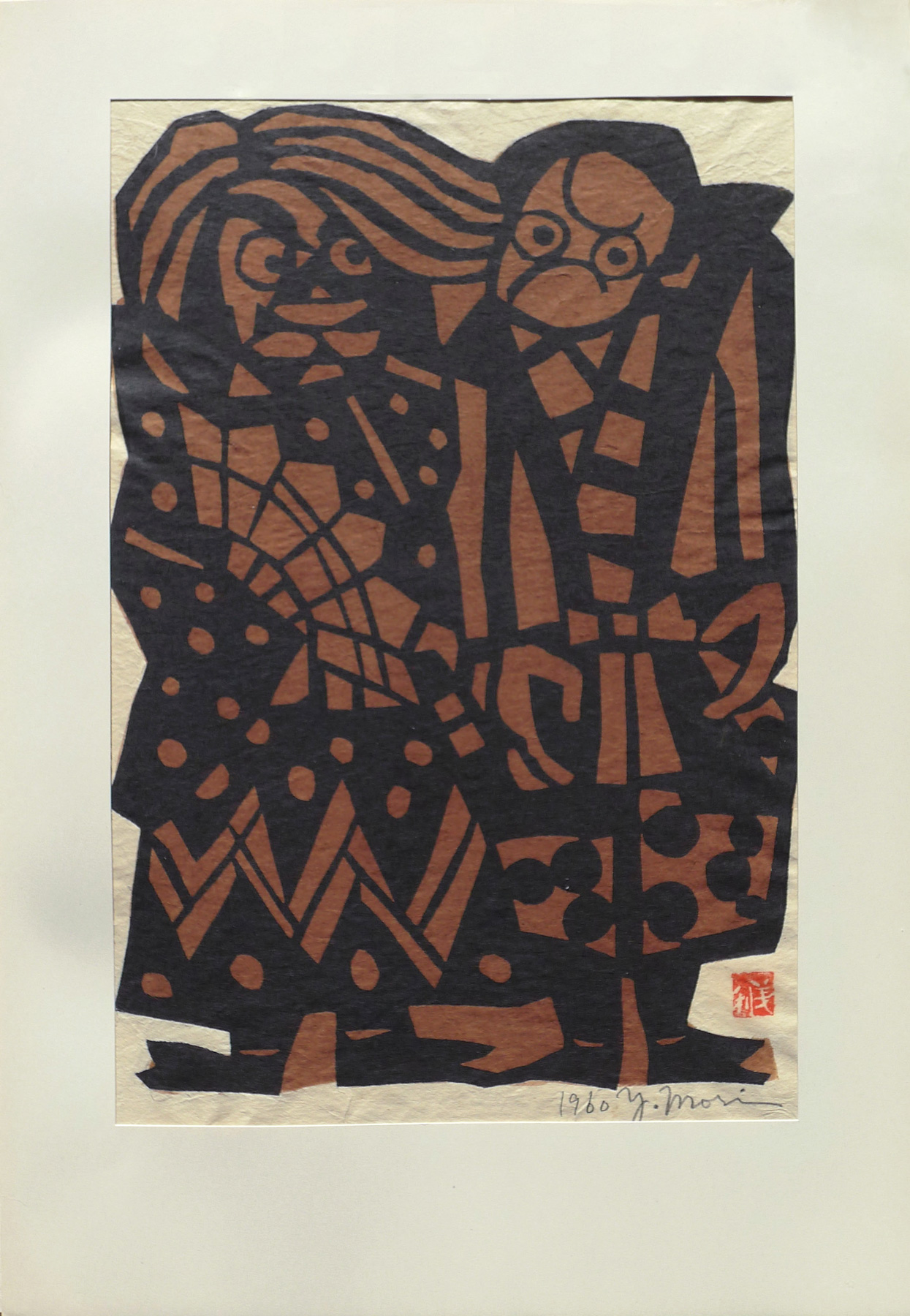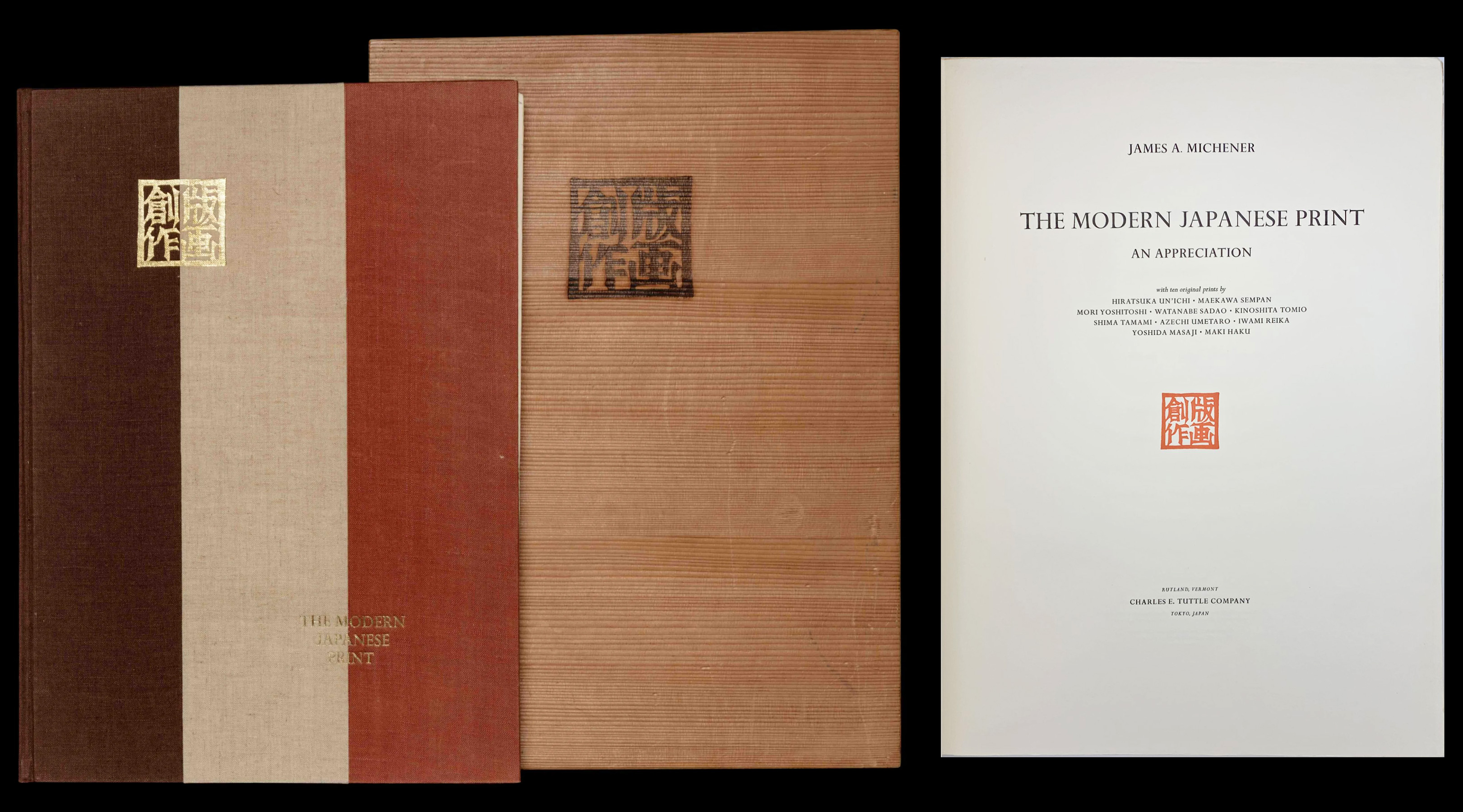About This Print
One of ten modern prints by ten different artists chosen for James Michener’s 1962 seminal work and portfolio of prints The Modern Japanese Print: An Appreciation, a work that brought Mori and the other artists to international attention.
"The Modern Japanese Print: An Appreciation" by James Michener
Note: Each print is tipped into Michener's book and placed under a mat that covers its margin, hiding the artist's signature, the print's title and the edition number on most of the prints.
In his introduction to this print, Michener writes in part:
Through the long history of dance in Japan, its most brilliant moments have often been captured in prints, for theatrical subject matter has always been a major preoccupation with print artists. It has been estimated that about thirty-five percent of classical prints dealt with theatrical themes; of these, many of the finest depicted dances....
It is therefore appropriate that one of the strongest prints included in this volume should be a present-day depiction of one of the oldest types of Japanese dance. More here shows us two oafish comedians engaged in the kind of Shinto dance that occurs at shrines like that of Kasuga as interludes between the more grave and sedate religious evocations. These comic interruptions have always been extremely popular with the common people, who must have found the hour-long religious dances somewhat tedious, for in time these ridiculous interludes gained a permanent home even in the Noh theater, form where they moved happily into the more robust Kabuki, where they now form one segment of almost every bill.
Who these two yokels are I do not know. Obviously they are the Oriental equivalent of Punch and Judy, of Bones and Sambo, of straight man and stooge. One feels instinctively that they are engaged in some outrageous business, for they are the timeless comedians of all who work, the necessary interruption in any well-organized theater. They are instantly recognized for what they are, and one of most pleasant recollections in working with these prints came when a New York theatrical producer hurried through my living room, took one look at the prints here assembled, stopped before this untitled Mori and exclaimed: "Ah, the comedians! How I wish I could find a face like that one!"
As a print-here, as in the terms of the contest, I follow the Japanese usage of so classifying stencils-this is a distinguished new work in an old technique. As a conscious art form the stencil had all but died out in Japan, remaining only in such folk-art forms as the lovely bijigata stenciled prints of Okinawa, until revived in the present century by such men as Yamagi Soetsu, the father of Japan's now-flourishing folk-art movement, and the distinguished stencil artist Serizawa Keisuke, to both of whom Mori acknowledges a debt of gratitude for guidance.
Here the stencil's bold line and heavy mass is made a decided asset. The colors have a somber theatricality about them, and the juxtaposition of the two idiotic figures is cramped and crowded like the proscenium of an Elizabethan stage. There is a fine sense of flatness about the print, and at the same time a sensation of weight. An oil painting of these two comic actors or even a woodblock print, each with its own characteristic texture, would make them look entirely different. This is a stenciled print, and the relation between colors, paper, and pigment is beautifully handled. The harsh simplicity of technique is wholly appropriate. The lack of shading and the reliance upon mass is appealing, and the total impression is one of quick message, vigorously delivered.
In many respects this is a peculiarly Japanese work, for the although the figures might have stepped from some rowdy passage of the Italian commedia dell' arte, the manner in which they are depicted is purely Japanese. The right-hand face, for example, comes straight from the puppet theater, and would be so recognized by any Japanese viewer, while the skirt and fan of the actor to the left recall both Noh and Kabuki. Then, too, the use of these particular colors is indigenous to Japan, as is the placement of the seal. This print could be as old as the dance itself. It could date from somewhere back in the eleventh century, for it is a timeless product of Japan. As such, it will be the last purely Japanese subject that we shall see in this book, and one leaves it with regret.
Mori's commentary:
This work was inspired by the comic Kagura dances given at Shinto shrine festivals throughout Japan. The dancers come onto the stage, generally a roofed outdoor platform in the shrine precincts, and to the accompaniment of the traditional drum and flute give hilarious pantomimes, which are also known as fools' dances. The idea for this print came from my fond childhood memories of such fools' dances.
The following technical information is also provided:
Artist's title: "Kagura no Doke" (Kagura Buffoonery). Self stenciled in two vegetable colors (sumi ink from pine soot and tangara brown) on hosokawa paper. The two stencils were made of a special paper from Shirako in Ise called shibugami (several thin layers of Japanese paper bound together with lacquer and moisture-proofed with persimmon tannin), strengthened with all-over sheets of fine-meshed cotton gauze. The black was applied two or three times and the brown three or four times to produce the desired density.
| IHL Catalog | #1336c |
| Title | Kagura no Dōke 神楽の道化 (Kagura Buffoonery) also seen translated as Comic Shinto Dancers |
| Series | |
| Artist | Mori Yoshitoshi (1898-1992) |
| Signature |  |
| Seal of Artist |  義利 Yoshitoshi |
| Date | 1960 |
| Edition | 463/610 |
| Publisher | Charles E. Tuttle Company, Tokyo |
| Printer | the artist |
| Impression | excellent |
| Colors | excellent |
| Condition | excellent - tipped into mat in the book The Modern Japanese Print: An Appreciation. |
| Genre | sosaku hanga (creative print) |
| Miscellaneous | |
| Format | dai-ōban |
| H x W Paper | 17 1/2 x 12 3/4 in. (44.5 x 32.4 cm) |
| H x W Image | 15 3/4 x 11 1/8 in. (40 x 28.3 cm) |
| Collections This Print | The British Museum 1981,0205,0.1.3; Portland Art Museum 2004.39c; Weatherspoon Art Museum, The University of North Carolina 1981.2837.3; Museum of Fine Arts, Boston 63.459; Brooklyn Museum 63.15.3; Birmingham Museum of Art, Alabama 1990.93.3; Philadelphia Museum of Art 1964-201-1(3); Honolulu Museum of Art 14936 |
| Reference Literature | The Modern Japanese Print: An Appreciation, James A. Michener, [with Ten Original Prints by Hiratsuka Un'Ichi, Maekawa Sempan, Mori Yoshitoshi, Watanabe Sadao, Kinoshita Tomio, Shima Tamami, Azechi Umetaro, Iwami Reika, Yoshida Masaji, Maki Haku], Rutland, Charles E. Tuttle Company, 1962; The Modern Japanese Print - An Appreciation, James Michener, Charles E. Tuttle Co., 1968 [the "popular edition"] |



